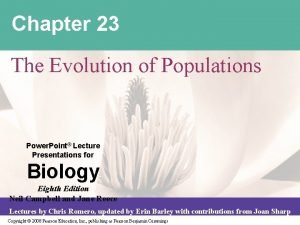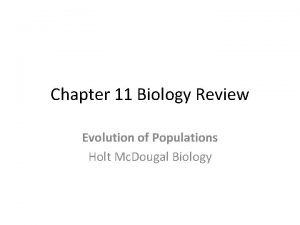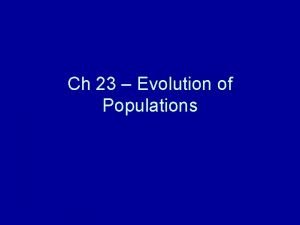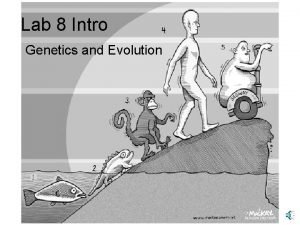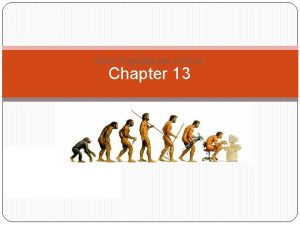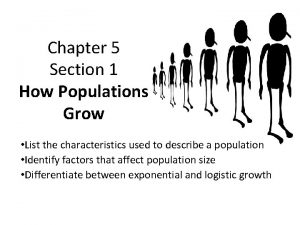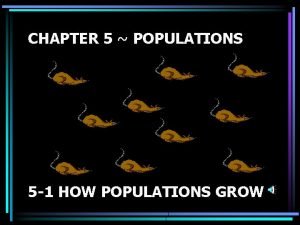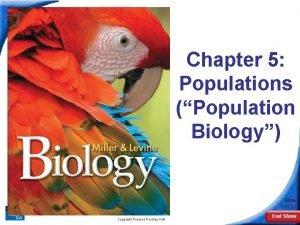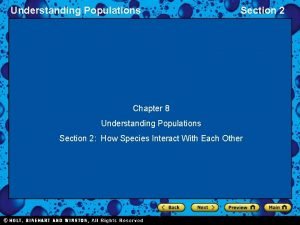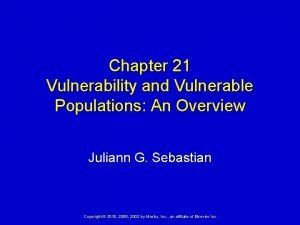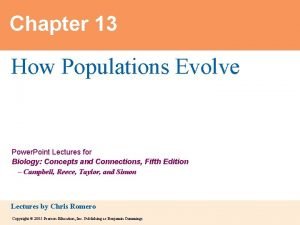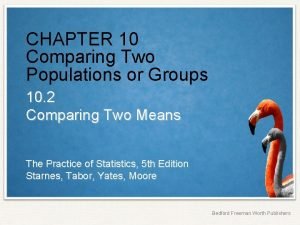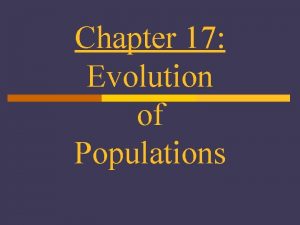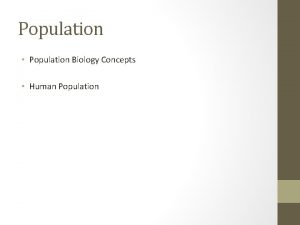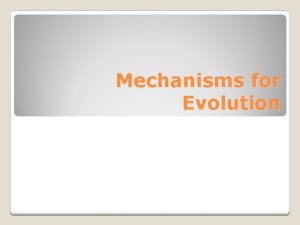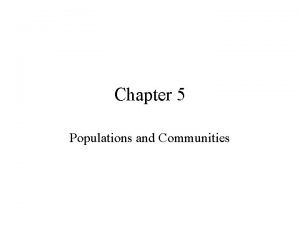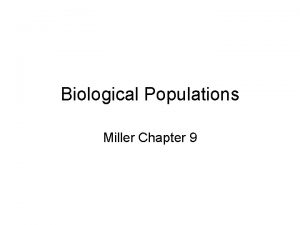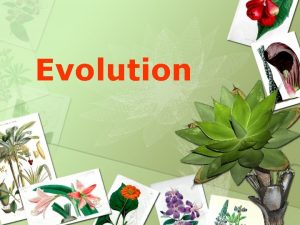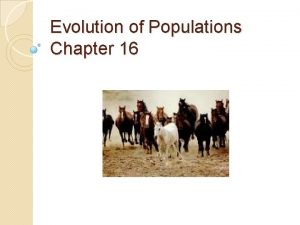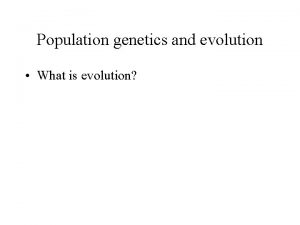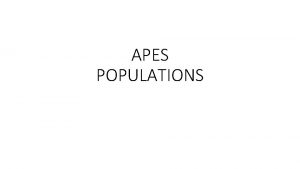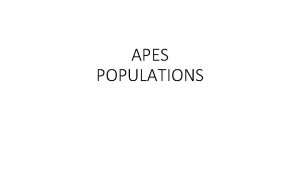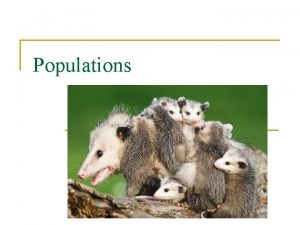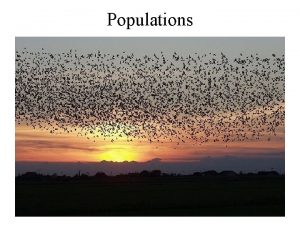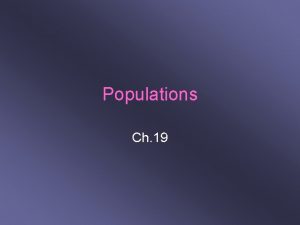Chapter 23 The Evolution of Populations A Population














































- Slides: 46

Chapter 23 The Evolution of Populations


A. Population Genetics 1. Combines Darwinian selection and Mendelian inheritance a. Population genetics is the study of genetic variation within a population. Importance of quantitative characters. b. In the 1940 s, a comprehensive theory of evolution, called modern synthesis, was formed. Until then, many did not accept that Darwin’s theory of natural selection could drive evolution.

- Modern synthesis combined discoveries from different fields including paleontology, taxonomy, biogeography, and population genetics. It emphasizes the importance of populations as units of evolution, with natural selection as the most important mechanism of evolution, and backs up the idea of gradualism.

2. Allele frequencies define gene pools Say that we have 500 flowering plants 480 with red flowers, 20 with white flowers and that the alleles express themselves by pure Mendelian inheritance. We know: Of the red, some will be RR and some Rr; Suppose 320 red are homozygous (RR) and 160 are heterozygous (Rr). The white will be only rr. We know there are 1000 copies of the genes for color (we know this because the plants are diploid). Thus, the allele frequencies are (in both males and females): 320 x 2 (RR) + 160 x 1 (Rr) = 800 R; 800/1000 = 0. 8 (80%) R 160 x 1 (Rr) + 20 x 2 (rr) = 200 r; 200/1000 = 0. 2 (20%) r

a. Remember, a population is a localized group of individuals of the same species. A species is a group of populations whose individuals have the ability to breed and produce fertile offspring. b. Individuals near a population center are, on average, more closely related to one another than to members of other populations.


c. A population’s gene pool is the total of all genes in the population at any one time. d. If all members of a population are homozygous for a particular allele, then the allele is fixed in the gene pool.

3. The Hardy-Weinberg Theorem a. The Hardy-Weinberg Theorem is used to describe a nonevolving population* Shuffling of alleles by meiosis and random fertilization have no effect on the overall gene pool. * Natural populations are not expected to actually be in Hardy -Weinberg equilibrium. Deviation from H-W equilibrium usually results in evolution. Understanding a non-evolving population, helps us to understand how evolution occurs.

b. Assumptions of the H-W Theorem: - Large population size: small populations can have chance fluctuations in allele frequencies (e. g. fire, storm) - No migration: immigrants can change the frequency of an allele by bringing in new alleles to a population - No net mutations: if alleles change from one to another, this will change the frequency of those alleles - Random mating: if certain traits are more desirable, then individuals with those traits will be selected and this will not allow for random mixing of alleles. - No natural selection: If some individuals survive and reproduce at a higher rate than others, then their offspring will carry those genes and the frequency will change for the next generation.

c. Hardy-Weinberg Equilibrium The gene pool of a non-evolving population remains constant over multiple generations; i. e. , the allele frequency does not change over generations of time. d. Hardy-Weinberg Equation 1. 0 = p 2 + 2 pq + q 2 where p 2 = frequency of RR genotype; 2 pq = frequency of Rr plus r. R genotype; q 2 = frequency of rr genotype Figure 23. 5 (p. 457) – The Hardy-Weinberg theorem.



But we know that evolution does occur within populations. What causes it? Microevolution refers to changes in allele frequencies in a gene pool from generation to generation. Represents a gradual change in a population. 1. Causes of microevolution a. Genetic drift - Genetic drift is the alteration of the gene pool of a small population due to chance. Figure 23. 7 (p. 461) – Genetic drift.


Two factors may cause genetic drift: - Bottleneck effect may lead to reduced genetic variability following some large disturbance that removes a large portion of the population. The surviving population often does not represent the allele frequency in the original population. Figure 23. 8 (p. 461) – The bottleneck effect: an analogy.



- Founder effect may lead to reduced variability when a few individuals from a large population colonize an isolated habitat (example, retinitis pigmentosa). b. Gene flow - Gene flow is genetic exchange due to the migration of fertile individuals or gametes between populations. Gene flow and human evolution:


c. Mutation - Mutation is a change in an organism’s DNA and is represented by changing alleles. -Mutations can be transmitted in gametes to offspring, and immediately affect the composition of the gene pool. -More coverage later in lecture.

The primary mechanism for adaptive evolution is: Natural Selection 1. Genetic (heritable) variation exists within and between populations. Exists both as what we can see (e. g. eye color) and what we cannot see (e. g. blood type). Remember, not everything that we see is due to the genotype, the environment can alter an individual’s phenotype (e. g. the hydrangea we saw before) Fig. 23. 9 – Map butterflies (color changes are due to seasonal difference in hormones).


a. Variation within populations Most variations occur as quantitative characters (e. g. height) that vary along a continuum usually indicating polygenic inheritance. Few variations are discrete (e. g. red versus white flower color). - Polymorphism is the existence of two or more forms of a character, in high frequencies, within a population. This applies only to discrete characters. An example would be the red versus white flower color.

b. Variation between populations - Geographic variations are differences between gene pools due to environmental factors. Natural selection may contribute to geographic variation. It often occurs when populations are located in different areas, but may also occur in populations with isolated individuals. Figure 23. 12 (p. 465) – Geographic variation between isolated populations of house mice. Normally house mice are 2 n = 40. However, chromosomes fused in the mice in the example, so that the diploid number has gone down. Note that populations are separated by mountains and that the populations evolved differently from each other!


- Cline, a type of geographic variation, is a graded variation in individuals that correspond to gradual changes in the environment. (Example: Body size of North American birds tends to increase with increasing latitude. Can you think of a reason for the birds to evolve differently? ) Figure 23. 11 (p. 464) – Clinal variation in a plant. Growth height has some genetic basis. Can you think of a reason for the plants to evolve differently?


2. Mutation and sexual recombination generate genetic variation (p. 459) a. New alleles originate only by mutations (changes in the nucleotide sequence of DNA). - In stable environments, mutations often result in little or no benefit to an organism. - Mutations are more beneficial in changing environments. (Example: HIV resistance to antiviral drugs) b. Sexual recombination is the source of most genetic differences between individuals in a population. - Vast numbers of recombination possibilities result in varying genetic make-up. FILM!

3. How is genetic variation preserved? (p. 466) a. Diploidy often hides genetic variation from selection in the form of recessive alleles (i. e. the dominant allele is expressed and the recessive allele can be maintained as a silent gene. ) àDominant alleles “hide” recessive alleles in heterozygotes. b. Balanced polymorphism is the ability of natural selection to maintain stable frequencies of at least two phenotypes. Includes: - Heterozygote advantage is one example of a balanced polymorphism, where the heterozygote has greater survival and reproductive success than either homozygote (Example: Sickle cell anemia where heterozygotes are resistant to malaria) Fig 23. 13 (p. 466) – Mapping malaria and the sicklecell allele.


-Frequency-dependent selection = survival of one phenotype declines if that form becomes too common (Example: Parasite-Host relationship. Co-evolution occurs, so that if the host becomes resistant, the parasite changes to infect the new host. Over the time, the resistant phenotype declines and a new resistant phenotype emerges. ) Figure 23. 14 (p. 467) – Frequency-dependent selection in a host-parasite relationship.



c. Neutral variation is genetic variation that results in no competitive advantage to any individual - Example: human fingerprints D. A Closer Look at Natural Selection as the Mechanism of Adaptive Evolution 1. Natural Selection increases the frequencies of certain alleles over a period of time that includes many generations. The way that natural selection works is twofold: a. Evolutionary (Darwinian) fitness Contribution of an individual to the gene pool, relative to the contributions of other individuals: the number of offspring may be greater or less than the number of offspring produced by others. . And,

b. Relative fitness - Contribution of a genotype to the next generation, compared to the contributions of alternative genotypes for the same locus. -Survival doesn’t necessarily increase relative fitness; relative fitness is zero (0) for a sterile plant or animal. àThere are three ways (modes of selection) in which natural selection can affect the contribution that a genotype makes to the next generation. These are (Figure 23. 12; p. 465 – Modes of selection. ): a. Directional selection favors individuals at one end of the phenotypic range - Most common during times of environmental change or when moving to new habitats.


b. Diversifying selection favors extreme over intermediate phenotypes. - Occurs when environmental change favors an extreme phenotype. c. Stabilizing selection favors intermediate over extreme phenotypes. - Reduces variation and maintains the current average.



3. Natural selection maintains sexual reproduction, p. 469 a. Sex generates genetic variation during meiosis and fertilization. This is the advantage of using sexual reproduction as opposed to asexual reproduction. -Generation-to-generation variation may be of greatest importance to the continuation of sexual reproduction. -However, there are disadvantages to using sexual reproduction. Asexual reproduction produces many more offspring. Figure 23. 16 demonstrates what happens when all individuals are female, versus half female/half male. Because males don’t reproduce, the overall output is lower for sexual reproduction. The variation produced during meiosis greatly outweighs this disadvantage, so sexual reproduction is here to stay.


4. Sexual selection leads to differences between sexes, p. 468 a. Sexual dimorphism is the difference in appearance between males and females of a species. - Intrasexual selection is the direct competition between members of the same sex for mates of the opposite sex. This gives rise to males most often having secondary sexual equipment such as antlers that are used in competing for females. - In intersexual selection (mate choice) one sex is choosy when selecting a mate of the opposite sex. This gives rise to often amazingly sophisticated secondary sexual characteristics, e. g. peacock feathers.



5. Natural selection does not produce perfect organisms, p. 469 a. Evolution is limited by historical constraints (e. g. humans have back problems because our ancestors were 4 -legged). The legacy of natural selection, our evolutionary history constrains what we can achieve. b. Adaptations are compromises. Humans are athletic due to flexible limbs, which often dislocate or suffer torn ligaments. c. Not all evolution is adaptive. Chance probably plays a huge role in evolution and not all changes are for the best. d. Selection edits existing variations. New alleles cannot arise as needed, but most develop from what already is present. Evolution adaptation is random and not goal-
 Chapter 16 evolution of populations vocabulary review
Chapter 16 evolution of populations vocabulary review Chapter 17 evolution of populations answer key
Chapter 17 evolution of populations answer key Chapter 23: the evolution of populations
Chapter 23: the evolution of populations Chapter 16 evolution of populations
Chapter 16 evolution of populations Chapter 23 the evolution of populations
Chapter 23 the evolution of populations Evolution of populations section 16-1 genes and variation
Evolution of populations section 16-1 genes and variation Evolution of populations section 16-1 genes and variation
Evolution of populations section 16-1 genes and variation Evolution of populations section 11 review
Evolution of populations section 11 review Why are populations the smallest unit of evolution
Why are populations the smallest unit of evolution Section 1 population dynamics answer key
Section 1 population dynamics answer key Chapter 4 section 1 population dynamics study guide answers
Chapter 4 section 1 population dynamics study guide answers Lab 8 population genetics and evolution
Lab 8 population genetics and evolution Population ecology section 1 population dynamics
Population ecology section 1 population dynamics Population ecology section 1 population dynamics
Population ecology section 1 population dynamics Chapter 13 how populations evolve test
Chapter 13 how populations evolve test Chapter 5 lesson 1 how populations grow answer key
Chapter 5 lesson 1 how populations grow answer key 5-1 how populations grow
5-1 how populations grow Chapter 10 comparing two populations or groups answer key
Chapter 10 comparing two populations or groups answer key 5-1 how populations grow
5-1 how populations grow Chapter 8 understanding populations
Chapter 8 understanding populations Chapter 21 vulnerability and vulnerable populations
Chapter 21 vulnerability and vulnerable populations Chapter 13 how populations evolve
Chapter 13 how populations evolve Chapter 10 comparing two populations or groups
Chapter 10 comparing two populations or groups Hình ảnh bộ gõ cơ thể búng tay
Hình ảnh bộ gõ cơ thể búng tay Ng-html
Ng-html Bổ thể
Bổ thể Tỉ lệ cơ thể trẻ em
Tỉ lệ cơ thể trẻ em Gấu đi như thế nào
Gấu đi như thế nào Chụp phim tư thế worms-breton
Chụp phim tư thế worms-breton Alleluia hat len nguoi oi
Alleluia hat len nguoi oi Các môn thể thao bắt đầu bằng từ đua
Các môn thể thao bắt đầu bằng từ đua Thế nào là hệ số cao nhất
Thế nào là hệ số cao nhất Các châu lục và đại dương trên thế giới
Các châu lục và đại dương trên thế giới Cong thức tính động năng
Cong thức tính động năng Trời xanh đây là của chúng ta thể thơ
Trời xanh đây là của chúng ta thể thơ Mật thư tọa độ 5x5
Mật thư tọa độ 5x5 101012 bằng
101012 bằng Phản ứng thế ankan
Phản ứng thế ankan Các châu lục và đại dương trên thế giới
Các châu lục và đại dương trên thế giới Thể thơ truyền thống
Thể thơ truyền thống Quá trình desamine hóa có thể tạo ra
Quá trình desamine hóa có thể tạo ra Một số thể thơ truyền thống
Một số thể thơ truyền thống Cái miệng bé xinh thế chỉ nói điều hay thôi
Cái miệng bé xinh thế chỉ nói điều hay thôi Vẽ hình chiếu vuông góc của vật thể sau
Vẽ hình chiếu vuông góc của vật thể sau Thế nào là sự mỏi cơ
Thế nào là sự mỏi cơ đặc điểm cơ thể của người tối cổ
đặc điểm cơ thể của người tối cổ Thế nào là giọng cùng tên?
Thế nào là giọng cùng tên?




